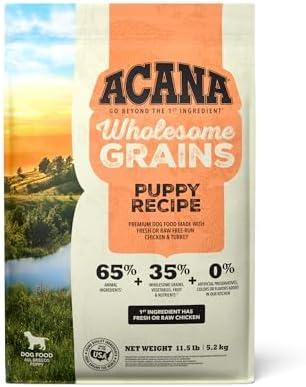When Sarah adopted Max, her energetic Labrador, she was determined to give him the best. One day, while shopping for dog food, she noticed a bag with a vibrant label boasting “premium ingredients.” Curious, she flipped it over. To her surprise, the first ingredient was corn, not meat. Sarah learned that quality dog food lists real meat first, avoids fillers, and includes wholesome grains and vegetables. By choosing wisely, she ensured Max thrived, proving that a little knowledge goes a long way in keeping our furry friends healthy and happy.
Contents
- Understanding Ingredient Quality and Sourcing for Optimal Nutrition
- Evaluating Nutritional Balance and Life Stage Appropriateness
- Recognizing Trusted Certifications and Brand Transparency
- Assessing Customer Reviews and Expert Recommendations for Informed Choices
- Q&A
Understanding Ingredient Quality and Sourcing for Optimal Nutrition
When evaluating the quality of dog food, one of the most critical factors to consider is the sourcing of its ingredients. High-quality dog food brands prioritize transparency in their ingredient lists, often sourcing from reputable suppliers who adhere to strict safety and quality standards. Look for brands that provide detailed information about where their ingredients come from, as this can be a strong indicator of their commitment to your pet’s health.
Another essential aspect of ingredient quality is the nutritional value they offer. Ingredients should be whole, recognizable, and rich in essential nutrients. **Key components to look for include:**
- **Real meat or meat meal** as the first ingredient, indicating a high protein content.
- **Whole grains or vegetables** that provide fiber and essential vitamins.
- **Healthy fats** like omega-3 and omega-6 fatty acids for skin and coat health.
Additionally, avoid dog foods that contain fillers, artificial preservatives, or by-products, as these can detract from the overall nutritional quality. Instead, opt for brands that utilize natural preservatives and whole food ingredients, ensuring that your dog receives the best possible nutrition.
Lastly, consider the brand’s commitment to quality control and safety. Reputable manufacturers often conduct regular testing and adhere to industry standards to ensure their products are free from contaminants. **Look for certifications from organizations such as:**
- **AAFCO (Association of American Feed Control Officials)**
- **NSF International**
- **FDA (Food and Drug Administration)**
By choosing dog food from brands that prioritize ingredient quality and rigorous sourcing practices, you can feel confident that you are providing your furry friend with optimal nutrition for a healthy and happy life.
Evaluating Nutritional Balance and Life Stage Appropriateness
When selecting dog food, it’s crucial to assess its nutritional balance to ensure your furry friend receives all the essential nutrients they need. A high-quality dog food should contain a well-rounded mix of proteins, fats, carbohydrates, vitamins, and minerals. Look for products that list specific animal proteins, such as chicken or beef, as the primary ingredient. This indicates a focus on quality protein sources that support muscle development and overall health.
Moreover, consider the life stage of your dog when evaluating food options. Puppies, adults, and senior dogs have different nutritional requirements. For instance, puppy formulas are typically richer in calories and nutrients to support rapid growth and development, while senior dog foods often contain fewer calories and added joint-supporting ingredients. Always check the packaging for labels indicating the food is formulated for your dog’s specific life stage, ensuring it meets their unique needs.
Another essential factor is the presence of **whole food ingredients** versus fillers. High-quality dog foods often include whole grains, fruits, and vegetables, which provide additional vitamins and fiber. Avoid products with excessive fillers like corn or soy, as these can detract from the overall nutritional value. Instead, prioritize brands that emphasize **natural ingredients** and avoid artificial preservatives, colors, or flavors, which can be harmful over time.
Lastly, consider the balance of omega fatty acids in the dog food. These essential fats play a significant role in maintaining healthy skin and a shiny coat, as well as supporting cognitive function and joint health. Look for foods that include sources of omega-3 and omega-6 fatty acids, such as fish oil or flaxseed. By ensuring your dog’s diet is rich in these beneficial components, you can promote their overall well-being and longevity.
Recognizing Trusted Certifications and Brand Transparency
When evaluating the quality of dog food, one of the most reliable indicators is the presence of trusted certifications. Look for products that have been certified by reputable organizations such as the Association of American Feed Control Officials (AAFCO) or the National Animal Supplement Council (NASC). These certifications ensure that the food meets strict nutritional standards and safety regulations, providing peace of mind that you are feeding your dog a balanced diet.
In addition to certifications, brand transparency plays a crucial role in determining the quality of dog food. A trustworthy brand will openly share information about their sourcing, manufacturing processes, and ingredient quality. Look for companies that provide detailed information on their websites, including:
- Ingredient sourcing: Where do their ingredients come from?
- Manufacturing practices: Are they following safe and ethical production methods?
- Quality control measures: What steps do they take to ensure product safety?
Another important aspect of brand transparency is the availability of third-party testing results. Reputable dog food brands often submit their products for independent testing to verify nutritional claims and safety. This not only demonstrates their commitment to quality but also allows pet owners to make informed decisions based on unbiased data. Brands that are willing to share these results are typically more reliable and dedicated to maintaining high standards.
consider the brand’s reputation within the pet owner community. Online reviews, testimonials, and recommendations from veterinarians can provide valuable insights into the quality of a dog food product. Engaging with fellow pet owners on forums or social media can also help you gauge the experiences of others. A brand that consistently receives positive feedback and demonstrates a commitment to quality and transparency is likely to be a good choice for your furry friend.
Assessing Customer Reviews and Expert Recommendations for Informed Choices
When it comes to selecting the right dog food, customer reviews can provide invaluable insights into the experiences of other pet owners. These reviews often highlight the **pros and cons** of specific brands and formulations, allowing you to gauge how well a product meets the needs of dogs similar to yours. Look for patterns in the feedback; if multiple customers report improvements in their dog’s coat, energy levels, or digestive health, it’s a strong indicator that the food may be of high quality. Conversely, be wary of consistent complaints regarding adverse reactions or lack of palatability.
Expert recommendations also play a crucial role in making informed decisions. Veterinarians and pet nutritionists often have access to the latest research and can provide guidance on what constitutes a balanced diet for your dog. They may recommend specific brands or ingredients based on your dog’s age, breed, and health status. **Consider seeking advice from professionals** who can help you navigate the myriad of options available, ensuring that you choose a food that supports your dog’s overall well-being.
In addition to reviews and expert opinions, it’s essential to examine the ingredient list of any dog food you’re considering. High-quality dog foods typically feature **real meat** as the first ingredient, along with a variety of whole foods that provide essential nutrients. Avoid products that list vague terms like “meat by-products” or “animal fat,” as these can indicate lower quality. A well-balanced formula should also include **fruits and vegetables**, which contribute to your dog’s health by providing antioxidants and fiber.
Lastly, don’t overlook the importance of certifications and testing. Look for brands that adhere to **AAFCO (Association of American Feed Control Officials)** standards, as this ensures that the food meets specific nutritional requirements. Additionally, brands that conduct feeding trials or have their products tested by independent laboratories demonstrate a commitment to quality and safety. By combining customer feedback, expert advice, ingredient scrutiny, and quality certifications, you can make a well-informed choice that will benefit your furry friend for years to come.
Q&A
-
What ingredients should I look for in high-quality dog food?
High-quality dog food should contain:
- Real meat as the first ingredient, indicating a primary protein source.
- Whole grains or vegetables for balanced nutrition and energy.
- Named animal meals (e.g., chicken meal) for concentrated protein.
- Healthy fats like fish oil or chicken fat for skin and coat health.
-
How can I identify harmful additives in dog food?
Be cautious of dog foods that contain:
- Artificial preservatives like BHA, BHT, and ethoxyquin.
- Fillers such as corn, soy, and wheat, which provide little nutritional value.
- By-products that may indicate lower quality ingredients.
-
Is the brand’s reputation important?
Absolutely! A reputable brand often reflects:
- Transparency in ingredient sourcing and manufacturing processes.
- Positive reviews from pet owners and veterinarians.
- Certifications from organizations like AAFCO, ensuring nutritional adequacy.
-
How can I assess the nutritional value of dog food?
To evaluate nutritional value, consider:
- AAFCO statement on the label, confirming it meets established standards.
- Guaranteed analysis for protein, fat, fiber, and moisture content.
- Life stage appropriateness (puppy, adult, senior) to ensure it meets your dog’s specific needs.
choosing high-quality dog food is essential for your pet’s health and happiness. By understanding ingredients, sourcing, and nutritional value, you can make informed decisions that ensure your furry friend thrives. Invest in their well-being today!

大家好,我是彼得潘,專業的手法身體治療師。我喜歡探索和研究各種主題,並透過與人工智慧的合作分享專業、實用、有趣的文章。我們定期進行人工審核,以確保內容的準確性。如果您發現文章中有任何不準確的地方,請隨時與我們聯繫,我們會及時糾正。您可以透過 [email protected] 與我們聯繫。



